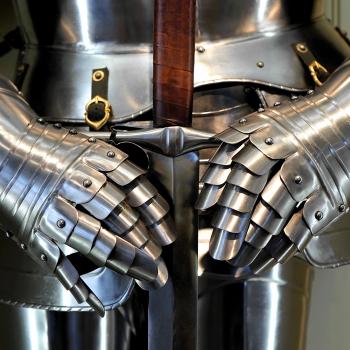To Train Up A Child, chapter 10, part 1
Now we begin the chapter on “safety training.” The basic gist is that you can get out of having to provide as much supervision if you make your children afraid of things that are dangerous—guns, hot stoves, and ponds or pools.
Some training has nothing to do with character building. It just keeps your child alive and healthy. These illustrations may sound harsh to some, but I have proven, along with many others, that this approach is both effective and safe.
Safe and effective, says Michael! Part of how he gets people to follow his ideas is by proclaiming that he has successfully raised five children on them—and they work! They’re safe! They’re effective! He promises!
GUN SAFETY
Being a hunting family, we have always had guns around the house. With little ones, we made sure to keep the guns out of reach. But, with the possibility of their sooner or later coming in contact with a loaded gun, we trained them for safety.
With our first toddler, I placed an old, unused and empty, single-shot shot-gun in the living room corner. After taking the toddler through the “No” saying, hand-switching sessions, they knew guns were always off limits. Every day they played around the gun without touching it. I never had to be concerned with their going into someone else’s house and touching a gun. I didn’t gun-proof my house, I gun-proofed my children.
My parents used to say this about the house in general—“we don’t childproof our house, we houseproof our children!” The problem with this is that the home should be somewhere the child feels safe and welcome. If the child has been struck for touching various things around the house, the house may not feel safe and welcoming.
I am the parent of two small children. One is in preschool and the other is a toddler. I am well familiar with all of the dangers from which I, as a parent, must protect my children—cars, guns, hot irons, even falling down the stairs. There are, in general, three approaches, which can of course be combined as appropriate. First there is teaching children about the danger, so that they can understand it and avoid it. Sally is at this point—she is good about looking across the road and knows not to touch guns, and why.
The second approach is to keep them from the danger. This is the approach I follow with Bobby, who is too young to understand the danger of cars and guns. When we’re outside near a road I stay within reach of him, and if we’re playing in a park or a grassy field I stay close enough to dash and grab him before he could complete a run for the road. When we’re at his grandparents’ house, we make sure there are no guns in his reach. It’s actually really not that difficult to keep a toddler from danger if you are serious about it.
The third approach is Michael’s approach, but I’ve heard it expressed differently in secular circles too. There was a time when Sally was younger when she was fascinated with roads and had no idea of the danger. I was afraid there might be a time I wouldn’t be close enough to grab her. I asked some friends in a mom’s group for suggestions, and they suggested that I wait for Sally to almost reach the road and then scream at the top of my lungs. They said that would startle Sally, and make her scared of roads, so that she would stay away from them voluntarily. Of course, Michael suggests causing the child physical pain (he has written that switchings must always cause pain) rather than simply frightening the child. Still though, the idea is the same—causing the child to fear the forbidden thing.
I don’t believe it is ever right to strike a child, especially not with the intent of causing pain. As for the more general idea of making a child frightened of that which is dangerous, I’m not so sure, but I will say that I don’t think it’s best practices or that it should ever be the first resort. I know that there are times when both my children have learned the seriousness of a danger by seeing my fear when sweeping them away from a close call, but intentionally frightening a child seems different. I worry that a parent might become overly confident that the child will avoid the danger and become less careful to stay within an arm’s reach (or keep guns out of reach). I also worry that there may be less emphasis on teaching children to understand the danger—notice that Michael doesn’t even mention teaching children why they shouldn’t touch guns.
Also, it’s worth noting that children learn to understand danger sooner than one might think. I started telling Bobby about cars being dangerous ages ago, long before I thought he could understand. I would crouch down by Bobby, holding onto him, and explain to him about cars, pointing as they passed. And it is already paying off. Bobby has recently started tentatively looking each way when he arrives at the edge of the pavement. Just the other day I was taking something out of the trunk and Bobby was a few feet from me standing in the parking lot when he noticed a car turning in at the other end, several hundred feet away. He immediately ran to me and threw his arms around my legs. Bobby won’t be two until this summer, and already he is learning to understand that he must be careful around cars.
HOT STOVE
We have always had a wood-burning stove for cooking and heating. Toddlers can be seriously burned by a red-hot stove. I have seen some awful scars. But, we had no fear, knowing the effectiveness of training. When the first fires of fall were lit, I would coax the toddler over to see the fascinating flames. Of course, they always wanted to touch, so I held them off until the stove got hot enough to inflict pain without deep burning—testing it with my own hand. When the heat was just right, I would open the door long enough for them to be attracted by the flames. I then move away. The child would inevitably run to the stove and touch it. Just as his hand touched the stove, I would say, “Hot!” It usually took twice, sometimes three times, but they all learned their lesson. Other than the training session, where we never even raised a blister, we never had a child get burned. It was so effective that, thereafter, if I wanted to see them do a back flip, all I had to do was say, “Hot!!” They would turn loose of a glass of iced tea.
These are the moments when it feels like Michael is describing a circus trick.
It actually doesn’t requiring letting a child burn herself to teach her that something is hot. Sometimes I will put food on Bobby’s tray when it’s still a bit warm for him. When I first did this I held his hands, held his hand close enough to feel the heat and steam coming off the food, and explained that the food was “hot.” And you know what? He got it! In fact, “hot” was actually one of his first words. Is there a reason Michael couldn’t have discussed the concept of “hot” with the child and held her hand close enough to the stove to feel the heat, without burning her?
Also, I have to say, having a wood stove that gets that hot in a place where children that small can access it sounds like a bad idea. What if the child does touch it one day? Why not instead focus on finding a way to keep the child from the danger? Perhaps some form of baby gate is in order. After all, what if the child is running by the stove and trips and falls against it? Raising a child in a home with open electrical wires or other hazards, after all, is considered child neglect. Part of good childrearing is providing proper supervision and basic safety.
SINKING FEELING
When our children were coming along, we lived in a house with a pond in the immediate yard. As they grew to be toddlers wandering around outside, we always watched them closely. Yet, knowing the possibility of one getting out of sight, we cranked up the training. On a warm spring day I followed the first set of wobbly legs to the inviting water. She played around the edge until she found a way to get down the bank to the water. I stood close by as she bent over reaching into the mirror of shining color. Splash! In she went.
Girl, it was cold. I restrained my anxiety long enough for her to right herself in the water and show some recognition of her inability to breathe. When panic set in (mine as well as hers—not to mention her mother’s), I pulled her out and scolded her for getting close to the pond. She didn’t swallow any water, and there was no need for resuscitation—except on my wife who took several hours to begin breathing normally. We repeated the same process with all the children. It took only one time for each of them to learn respect for the water. And it got easier on us.
We did have trouble with one of them. She is the one who became mobile early, crawling at four months and walking at seven. She always had marvelous coordination. She just wouldn’t fall in. I got weary taking walks to the pond. So, to bring the class to graduation, I pushed. Oh, she didn’t know it. As she was balanced over the water, I just nudged her with my foot. To this day, I still believe that if I had left her alone she would have swum out. But, it distressed her enough to make her not want to play around the pond.
No, they didn’t stay distressed of the water. My children were all swimming by the time they were four. We still closely watched them, and we never had a close call. The training worked. Do not try this unless you are sure that you can maintain full control of all the circumstances.
My parents did this. We had a pond near our house, and my parents worried about the little ones getting out of the house alone and drowning. So the first time we would go out swimming when the youngest child was toddling, my parents would let her have free rein, just let her walk out into the pond until she got too deep and lost her footing, went under, and started flailing. Then they’d grab her and pull her out. Did it work? Did it instill a healthy respect for the danger of water? No, or at least not at as well as Michael claims. The little ones still had to be watched carefully when swimming, and I remember one near miss when I only just barely pulled in a small sister who got in over her head. There was another time when we were at the pool with relatives and a small brother quite literally almost drowned—he was pulled out only just in time. We also still had to be extremely careful when taking the little ones outside to play to make sure they didn’t make a beeline to the pond, and the marshes and reeds around it.
Today, when I take Sally and Bobby to the pool, Sally avoids getting her head in water but Bobby’s favorite activity is jumping off the edge of the pool into my arms. He prefers to go all the way under the water, with my arms right there to grab him and pull him up, laughing, out of the water. He thinks it’s hilarious. I’m really careful, of course, to pull him back up immediately, but many another mother at the pool has commented on his impressive daring. Does Bobby’s confidence around water make me nervous? Yes! But it also makes me determined to make sure he is always carefully supervised around water.
My parents also applied these ideas to babies and the stairs. Any parent knows that you have to be careful not to let a crawling baby fall down the stairs. My mother would take the baby to the stairs, go down several steps in front of the baby and look up at the baby, and then wait for the baby to topple over the edge. After letting the baby fall down several steps, my mother would catch the now crying, frightened, and hurt baby. This was supposed to teach babies to stay away from the stairs and thus inoculate them from falling down the stairs. It strikes me that even if in some cases this technique may cut down on danger, it may also cut down on curiosity and willingness to explore and try new things. It can also be dangerous.
It strikes me that all of these safety techniques are ways to get out of properly supervising children. Part of being a parent is making sure children, and especially small children, are properly supervised. As children grow and are better able to understand dangers and better able to handle those dangers, they need less supervision. Michael doesn’t appear to like carefully supervising his children, and seems to prefer quick fixes that will somehow inoculate them against childhood dangers by instilling fear. Call me crazy, but I’m sticking with providing supervision and facilitating understanding.









